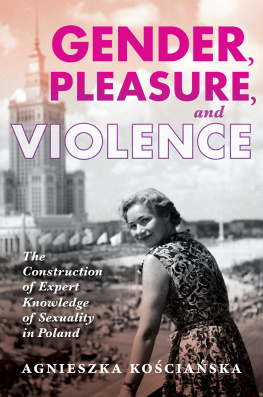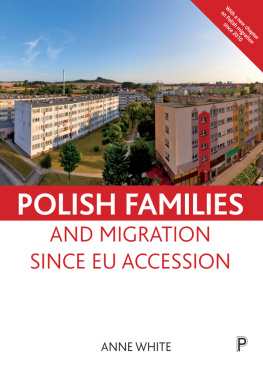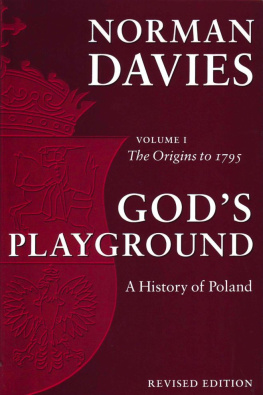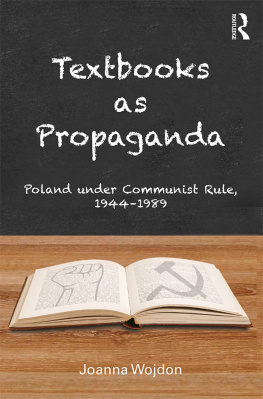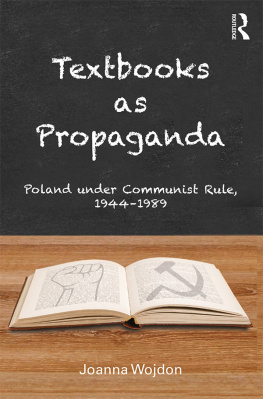To See a Moose
European Anthropology in Translation
Published in Association with the Society for the Anthropology of Europe (SAE), a Section of the American Anthropological Association (AAA)
General Editor: Nicolette Makovicky, University of Oxford
This series introduces English-language versions of significant works on the Anthropology of Europe that were originally published in other languages. These include books produced recently by a new generation of scholars as well as older works that have not previously appeared in English.
Volume 9
To See a Moose: The History of Polish Sex Education
Agnieszka Kociaska
Volume 8
Heirs of the Bamboo: Identity and Ambivalence among the Eurasian Macanese
Marisa C. Gaspar
Volume 7
Raccomandazione: Clientelism and Connections in Italy
Dorothy Louise Zinn
Volume 6
Hunters, Gatherers, and Practitioners of Powerlessness: An Ethnography of the Degraded in Postsocialist Poland
Tomasz Rakowski
Volume 5
Two Sides of One River: Nationalism and Ethnography in Galicia and Portugal
Antnio Medeiros
Volume 4
The Colours of the Empire: Racialized Representations during Portuguese Colonialism
Patrcia Ferraz de Matos
Volume 3
Developing Skill, Developing Vision: Practices of Locality at the Foot of the Alps
Cristina Grasseni
Volume 2
Strangers Either Way: The Lives of Croatian Refugees in Their New Home
Jasna apo mega
Volume 1
Disenchantment with Market Economics: East Germans and Western Capitalism
Birgit Mller
To See a Moose
The History of Polish Sex Education
Agnieszka Kociaska
Translated by Philip Palmer
Published in 2021 by
Berghahn Books
www.berghahnbooks.com
English-language edition
2021 Berghahn Books
Polish-language edition
2017 Agnieszka Kociaska
Originally published by Wydawnictwo Czarne as Zobaczy osia: Historia polskiej edukacji seksualnej od pierwszej lekcji do internetu in 2017
Cruising the 1970s: Un-earthing Pre-HIV/AIDS Queer Sexual Cultures (CRUSEV) was financially supported by the HERA Joint Research Programme 3 Uses of the Past, which is co-funded by AHRC, BMBF via DLR-PT, MINECO, NCN, and the European Commission through Horizon 2020.
This project has received funding from the European Unions Horizon 2020 research and innovation programme under grant agreement No 649307.
All rights reserved. Except for the quotation of short passages for the purposes of criticism and review, no part of this book may be reproduced in any form or by any means, electronic or mechanical, including photocopying, recording, or any informationw storage and retrieval system now known or to be invented, without written permission of the publisher.
Library of Congress Cataloging in Publication Data
Names: Kociaska, Agnieszka, author.
Title: To see a moose : the history of Polish sex education / Agnieszka Kociaska ; translated by Philip Palmer.
Other titles: Zobaczy osia. English
Description: English-language edition. | New York, N.Y. : Berghahn Books, 2021. | Series: European anthropology in translation ; volume 9 | Originally published by Wydawnictwo Czarne as Zobaczy osia : Historia polskiej edukacji seksualnej od pierwszej lekcji do internetu in 2017Title page verso. | Includes bibliographical references and index.
Identifiers: LCCN 2020051915 (print) | LCCN 2020051916 (ebook) | ISBN 9781800730601 (hardback) | ISBN 9781800730618 (ebook)
Subjects: LCSH: Sex instructionPolandHistory.
Classification: LCC HQ57.6.P7 K6713 2021 (print) | LCC HQ57.6.P7 (ebook) | DDC 613.907109438dc23
LC record available at https://lccn.loc.gov/2020051915
LC ebook record available at https://lccn.loc.gov/2020051916
British Library Cataloguing-in-Publication Data
A catalogue record for this book is available from the British Library
ISBN 978-1-80073-060-1 hardback
ISBN 978-1-80073-061-8 ebook
Foreword
Frances Pine
Sex education may sound like a topic of interest primarily to pedagogues, public health practitioners and planners, and religious ideologists. It is all of those things. But anyone familiar with the history of early feminist movements, or the ideological struggles over reproduction, regulation of sex, sexuality and birth control throughout the nineteenth and twentieth centuries, will recognize these as other dimensions to the topic. And these issues have been at the core of many of the most critical debates about equality, rights and general political participation over the past century and a half. Easily dismissed as gender matters (and hence rather trivial) or as sexual matters (and hence private and intimate things), the topics in this book are shown by Agnieszka Kociaska still to be of critical political, social and ideological importance in the twenty-first century. And, as this book shows, Poland has been historically, and continues to be, one of the main battlegrounds where these ideological wars are being fought out.
In the early 1990s, Poland was undergoing one of the most brutal restructuring programmes in all of the postsocialist states. The Balcerowicz Plan acquiesced to the demands of the International Monetary Fund and the World Bank, and introduced draconian cuts to health and social services, education and industry in other words, to the entire public sector. At the time, I was doing fieldwork in and around d, on the unemployed textile workers and the massive factory closures, d was being hit very hard by the restructuring programme and unemployment, particularly female unemployment, was extremely high. The general mood was one of anxiety, shock and discontent. All summer, Polish radio broadcast live debates from the Sejm, the Polish Parliament. Although the main topics of conversation in ordinary household kitchens, on the streets and in markets were factory closures, unemployment, visible poverty and so forth, these were not broadcast on the radio. The Sejm debates were all about abortion. There were proposals, backed by the Polish Catholic Church, the Catholic intelligentsia and the then growing nationalist right, to ban abortion except in the direst circumstances of incest, rape or threat to the mothers life. For some, even those exceptions went too far, and they called for all abortion to be illegal. In the city of d and the countryside around it, on the other hand, I spoke to women and men, old and young, peasant farmers, factory workers, market sellers, small-time entrepreneurs and dealers, and everyone I spoke to was absolutely clear abortion is a private matter for a woman and her doctor, for a woman and her own conscience. It has nothing to do with politicians and priests. If these laws were passed, women would die in the backstreets the way they used to. The sentiments expressed were deeply felt and highly emotionally charged. They also reflected a memory, personal or received, of a time before socialism when womens lives were under continual threat because of accidental or unwanted pregnancy and the lack of a legal and safe possibility of dealing with that threat.


